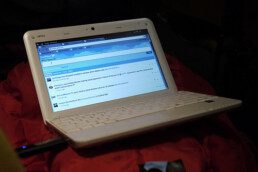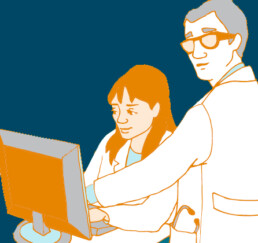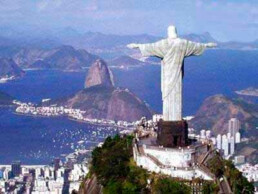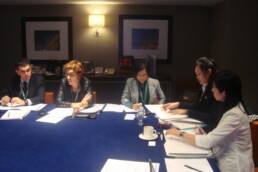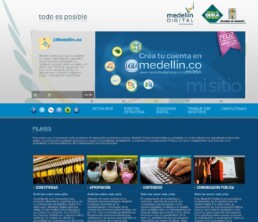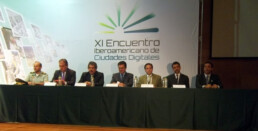Internet users between 45 and 64 narrow the digital divide
The population of this age increases its presence in the network more than the average
The elders do not take full advantage of internet potential
The digital divide between generations which is the difference by age of the use of new technologies is becoming closer. In its latest report, Telefónica concluded that the population between 45 and 64 is the sector that contributed to the advancement of information society in 2010, with inclusion rates above average. This helps to alleviate some suffering and loneliness that keeps them intellectually active
The current concern, says expert in information society José Manuel Robles, has less to do with joining the network but with the "difference of uses" that make young people and adults in the possibilities of the Internet. Beyond that show even greater reluctance to join social networks usually do not take full advantage offered by the network to interact with management and purchase items without scrolling. Most are content to seek information and communicate, "but not beyond, " he explains.
Source: elperiodico.com
ICT for next generation Cities
The challenge of fast urbanization is opening the way for the development of highly "smarter" cities, as more and more of its services rely on emerging technologies. The differentiating factor that can make cities "smart" is the integrated usage of information and communication technologies (ICT) in optimizing the flow of information between seven critical city infrastructure services: administration, education, healthcare, public safety, real estate, transportation, and utilities. By implementing initiatives based on this information to enhance efficiency and performance of these services to the citizen you create cities that are "smarter."
From the administration point of view a smart city will have a reliable system to reach the citizens effectively, to receive feedback, to collect data, to generate statistics and to properly communicate political decisions in a transparent manner. This will support decisions makers with the necessary knowledge required to make acute and quick decisions on city planning and maintenance.
Use of ICT in education services will improve the quality and experience while reducing costs. In developing countries, providing internet access to the educational resources will increase attendance, especially when targeting rural populations surrounding the city or individuals who cannot participate to daily courses. Usage of digital content and collaboration technologies will reduce costs while providing a higher quality and improved experience.
Smart healthcare systems can provide faster and more reliable services. Using scalable storage systems and wide communication platform, patient records con be stored and shared with any medical unit which requires them. Also the communication platform can be used to improve response time in case of emergency services. This is key during a time where epidemics are spreading across cities and information of patient diagnosis is pivotal to diagnosing and treating new patients.
Public safety can make use of communication technologies to reduce deployment time of the emergency response units. In the same time the communication network could be use to relay real-time information between dispatchers and filed units. While dispatchers have access to information via desktop computers, field units can access the network via handheld devices. Public safety services can also make use of closed-circuit television (CCTV) combined with video analytics and global positioning services in order to optimize deployment time. All of these allow for effective, immediate transition of data so that disturbances can be identified and controlled in an aggressive manner.
In real estate ICT can help reduce operating costs by using management systems to automate heating, cooling and illumination. Through motion, temperature, and weight censoring, lighting and cooling units can be controlled to operate at the most efficient levels. From inception, computer modeling will help in building design and identifying appropriate materials, architectural design as well adherence and reporting to relative green building certifications such as LEED.
Transportation can benefit from reduced traffic congestion and more efficient public transport by implementing smart computing technologies like congestion pricing. By passing through electronically controlled tolls, drivers pay more to use more congested roads in rush hours. Not only it reduces traffic congestion, but reduces the environmental impact of the transportation service while raising funds for the public transport.
Utilities can make use of smart grids to optimize water, gas and electricity consumption. Smart grids help identify water leaks and electricity losses. Also, transparency in the measurements towards the consumers can help in responsible usage behaviors and improve demand side management. Replacement of the carbon-intensive fuels with renewable energy can also contribute to "smarter" utilities by ensuring they are tapping into endless resources.
For the success of a smart city project ICT must be at the core of city planning and design. You cannot manage what you cannot measure, and you cannot accurately measure in real time without effective ICT tapping into all aspects of your city and aggregating the data.
Source: www.theurbanvision.com/
Medellín: wireless connectivity in education
The implementation of wireless broadband network puts Motorola certainly evidence that the recent selection of Medellin in the Digital Cities Motorola ranking as one of the 25 cities with a higher level of digitalization in Latin America, is not mere coincidence but the result a strong commitment. Commitment Motorola is proud to follow through technology.
"Digitization is not a feature unique to big cities or countries with higher GDP and greater penetration of telecommunications services, as the systematization of processes such as education is an attribute that can be adapted to any municipality, because today These days the technology is flexible and applicable to any city and geography, "said Manuel Riaño, regional manager of Broadband and Mobile Computing, Motorola, and adds," Motorola is proud to participate in initiatives like this that can provide better education to young people in Colombia. "
Technically, the implementation of this network were used wireless bridges PTP 300 Series Motorola OFDM and equipment that enable advanced features, providing reliable, high performance connectivity, even in obstructed or high level of interference. These systems offer excellent options for companies and governments who need to maintain connectivity between buildings, access to high-speed Internet and backhaul applications, voice over IP, multimedia and video.
Thus this new step, the capital of Antioquia continues its march toward a society that uses technology resources and provides its residents new and better possibilities of education.
Source: Educational technologies
71 percent of the world´s population uses mobile
In total, two billion people already have Internet access worldwide
At the Consumer Electronics Show (CES) held a few days in Las Vegas, president of Verizon, Ivan Seidenberg said that 71 percent of the world´s population already uses mobile phone and two billion people have Internet access. However, if there is something to be imposed this year 2011 is the 4G wireless network, thanks to the wave of product launches mobile operators to meet consumer demand. By Gloria Navas
71 percent of the global population, representing around five billion people use mobile phones and 2,000 million people have Internet access. That has been one of the ideas being taken up by the Consumer Electronics Show (CES), which was held these days in Las Vegas.
According to the Center for Research and Innovation in Telecommunications (Cinit) 2011 President and CEO of the company Verizon (one of the largest companies in the world), Ivan Seidenberg, said in his speech, also attended by directors of other companies ten years ago the broadband Internet barely existed and only one in three Americans had this service.
Faced with this data, now nine out of ten people enjoy this service and this is causing the wireless communications traffic to double every year. Similarly, sales of smartphones are growing 90 percent a year.
And if something from this year is going to impose it is the 4G wireless network, explains that he CBB. Until now, consumers who wanted to seize it did not have much choice with the devices that were in the market. This dynamic will change dramatically this year thanks to a flurry of product launches mobile operators seeking to meet growing consumer demand for wireless broadband faster and attract more revenue from data traffic.
Internet
Moreover, Seidenberg said that five years ago, the Internet video transmission amounted to only 10 percent of the total network traffic, while the middle and now totals may reach 90 percent in the near future.
The executive announced that very soon the three-dimensional television is the most common, like smart homes, smart cities, and the machines that communicate with other machines, among other things.
The chief operating officer of Verizon, Lowell McAdam, predicted, in turn, to participate in the forum, that within five years his company´s customers will have access to internet connection speeds of 100 gigabytes. That will handle the enormous growth in video traffic in the coming years.
On the other hand, Jeff Bewkes, President and CEO of Take Warner, said during his participation in the event that the world is watching more TV than ever and said it is starting to live now the second golden age of television. "Everything is increasing including the number of viewers, the ad, the budgets for programming and talent and quality," he said.
Bewkes noted that all visual content that was previously restricted to television, is now moving all types of attachments, including a cell phone.
Source: Trends in Telecommunications
The advantages of a Health 2.0 for society
In 3 years it has doubled the number of Internet users seeking information about the Health on the Net in 2006, 19% of the population in the European Union had used the Internet for this purpose, and in 2009, according to the report The Company Information in Spain 2010, and is 33% of the population.
The Spanish are concerned, above all, diseases, healthy eating, and drugs. These are the three main topics of Internet search users from Spain. Furthermore, the assessment by the Internet in our country is better than the rest of Europe, but at the same time, aware of the possibility of finding false information which leads to distrust. "The problem is that users have identified the health reference website, so no doubt this is an issue which must go in the future," the report says in reference to a similar study that Pfizer conducted the last year entitled ´The role of Internet in the consultation process on Health Information. "
New technologies and access to the online world is being felt also in health services. The European Union has calculated that his adaptation would mean a saving of 7,500 million euros each year in Europe. Another important attribute of this evolution is the reduction of up to 84% of patient medication errors.
The report notes Telefónica as an example of the use of e-health in Spain for electronic medical records, a tool that is already used by almost all family physicians and pediatricians in Spain (87%.) The appointment request through the network has been another major advantages of using Internet for the Healthcare System, and over 80% of health centers have this service running.
Not so with the use of electronic prescriptions, but the perspective is of great benefits such as congestion of the health centers. According to estimates, could be reduced up to 30% of visits to health centers for this service so that doctors will make more time for other patients. And consequently, the waiting time is also reduced to 16%.
Source: prsalud
The City of Rio de Janeiro and IBM sign a partnership to turn Rio into a smart city
The city will integrate data and processes of government agencies in a single center of operations
The municipality of Rio de Janeiro and IBM signed an agreement for the construction of a Center for public information management in the city of Rio de Janeiro. The Rio Operations Center, which will be located in Cidade Nova, will integrate and interconnect the public information of the municipality to improve safety and responsiveness of the city on various types of incidents such as flooding and landslides. The agreement also includes plans to develop a pioneering system called "High Resolution Weather Prediction" - PMAR - that predicts heavy rain with 48 hours notice.
The mission of Rio Operations Center, which opens on December 31, will be to consolidate information from various systems of the municipality to enable real time visualization, monitoring and analysis. The system was initially designed for flood forecasting and related emergencies, but may extend to any act occurring in the city, from incidents in the Reveillon in Copacabana beach, to the fans out of a soccer game at Maracana or a traffic accident. The Centre will allow city leaders to make decisions in emergency situations, based on real time information.
The initiative is part of IBM´s global strategy that aims to develop technologies that help cities function more intelligently. Similar projects have been implemented in New York and in Gauteng (South Africa), but this is the first center in the world to integrate all the stages of crisis management: from forecasting, mitigation and preparedness, immediate response to events and the feedback of the system with new information that can be used in future incidents. Other partners involved in the construction and operation of the Center include Cisco, Cyrela, Facilities, Malwee, Oi and Samsung. The idea is that the center evolves continually and integrates more and more agencies and information sources in the city. "We are creating a great technology platform that soon will compile all incidents and events occurring in the city," said Pedro Almeida, Director of Smart Cities of IBM Brazil.
The PMAR will begin operations in the first half of 2011 and will be key element for Rio Operations Center. The system is based on a unified mathematical model for the city of Rio de Janeiro, which includes the collection of data from the watershed, topographic relief, the town´s historic rains and information from satellites and radars, which will be able to predict the incidence of rain and possible flooding. Both the system and the mathematical model must be calibrated to significantly increase the success rate in relation to the forecast of rain in the city. After detecting the occurrence of rain, potential flooding and modeled system at a later stage, will also be able to assess their impact on vehicle traffic in the city. This is the first project of the ninth global research laboratory of IBM, which recently opened in Brazil.
On 9th and 10th November, Global President of IBM, Samuel J. Palmisano and the Mayor of Rio de Janeiro, Eduardo Paes, gathered with leaders and experts from around the world in the city to celebrate the Fourth Regional Forum Smart Cities. With special focus on Latin America and the growing markets of the world, IBM will continue the conversation begun in Berlin, New York and Shanghai to discuss how cities can deal with serious situations currently being experienced urban and improve quality of life for its citizens.
Source: one-digital
Internet Governance Forum
The UN General Assembly will soon debate the renewal of the mandate of the Internet Global Forum (IGF), which has its origin in the World Summit on the Information Society (WSIS) held, after a long preparatory process of seven years in two phases, Geneva 2003 and Tunis in 2005. The Basque Country took an active part in this process which led to the creation of the international network of local authorities IT4ALL in 2003 and organized the Second World Summit of Cities and Local Authorities on the Information Society in Bilbao in November 2005.
The WSIS was convened to discuss how to reduce inequality in access and use of the Internet and to overcome the global digital divide. However, the discussions centered on how the Internet should be governed, and debated the control of the United States over the domain of the names system. In order to solve this controversy it was created the Working Group on Internet Governance, with the task of defining the outlines of the government of the Network. The Group´s report suggested an innovative idea, compared to the controversy over who should lead the Internet - governments or private sector-, it proposed to foster communication between the different groups involved as the basis for such regulation, this means, the creation of an open platform for political dialogue. This is how the Forum was born.
The IGF has some innovative features that differentiate it from other United Nations meetings. UN meetings are primarily intergovernmental, there is an order of the intervention of representatives of governments and is usually done from a platform. In the IGF there isn´t an established order of interventions and everyone participates on equal conditions. If a civil society representative raises his hand before a representative of a government, he intervenes before. This is because it assumes that everyone has equal opportunities for expressing their views and because the purpose of the Forum is to foster discussion among different groups. Another important feature is that IGF is not required to present a declaration or final document under consensus. It is precisely this lack of obligation which allows a constructive political dialogue between companies, international organizations, civil society and governments. The purpose of the Forum is not to make policy decisions, but to provide guidance on specific issues of Internet governance.
In September took place in Vilnius, Lithuania, the fifth meeting of the IGF under the theme "Building the Future Together." There were about 1.500 attendants from 107 countries and about 2.000 people around the world followed the debates and workshops on the Internet. Issues such as network neutrality, cloud computing, social networks, the balance between security and rights in the context of Information Technologies and Communication Technologies (ICT), Internet governance for development, promotion of access and promotion of linguistic and cultural diversity to make the Internet a more inclusive tool were discussed during this meeting.
Although it is too early to make an assessment of the impact of the Forum, we can draw some interesting conclusions. The first is to reduce the ideological features that conditioned the debate in the World. Although that claim remains, the IGF has addressed the issue from a more pragmatic and operational perspective through the incorporation of the views of the private sector and civil society, significantly different from the approach of governments. It has also helped not having to seek consensus on specific text. The participants have achieved a level of more constructive dialogue in addressing issues that are known in advance that there are divergent views. Thus, the Forum´s discussions have gained in maturity and confidence between the parties.
The mechanism of the IGF has also had a multiplier effect. In recent years there have been created forums in diverse countries and regions in which they address the issues of Internet-centric perspectives local and regional needs. Over the next few years we will witness the proliferation of these forums. At this point the renewed mandate of the Forum depends on the resolution adopted by the UN General Assembly. Although almost all participants have advocated the continuation of the IGF and the general feeling is that its mandate should be renewed, it is unclear on what terms it will be.
There are interests from some governments for the IGF to be submitted to UN procedures and a greater governmental control which could influence its open and participatory condition. The recent announcement made by the executive coordinator Markus Kummer, informing that he will no longer continue in office for a second term, generated many uncertainties.
However, one of the most important challenges facing the IGF for the future is to make visible their work to the Internet community and to international society.
Source: El Correo
The Executive Bureau approves the renewal of the Committee for other 3 years
From the 17th to the 20th November 2010 took place in Mexico City, the III World Congress of UCLG "World Summit of Local and Regional Leaders" that gathered more than 2.000 local and regional leaders from all over the world.
One of the main issues to be discussed during the Executive Bureau held on the November 17th was the renewal of mandates of the Committees and Working Groups of UCLG for the period 2011 - 2013.
In this sense, and after consultation with the Advisory Team and the Committee of Statutory Affaires, the Presidency proposed to the Executive Bureau to recommend to the World Council the renewal of all the Committees and Working Groups that have requested it, for an additional mandate and to prepare the transition towards the transformation and reduction of the Committees and Working Groups. With this, the Committee of Digital and Knowledge-based Cities will be able to continue working for other 3 years to position local governments as leaders in the innovation processes.
The Committee also took the opportunity of the III World Congress to meet with the committee members on the morning of the 17th prior to the Executive Bureau, to discuss in a more informal way about the future of the committee taking into consideration the renewal of the committee.
During the meeting, the attendees were informed about the renewal process of the committee for the mandate 2011-2013.
The diverse activities developed during 2010 were presented: official website of the committee, the Committee Forum, the Committee TV Channel, exchange of knowledge, founds search, Observatory, etc.
It was also discussed the Next activities to be developed, among them the First Study on the situation of ICT, Innovation and Knowledge management in UCLG´s members and the need of collaborating closely with UCLG´s World Secretariat, UCLG´s Regional Sections and above all, the Vice-presidencies of the Committee, for the obtaining of information in their regions.
Within the proposals made during the meeting, it was transmitted the need of creating regional nodes of the committee led by the Vice-presidencies. They would be responsible of boosting the work of the committee in the different areas. These regional nodes will give support for the obtaining of information for the First Study on the situation of ICT, Innovation and Knowledge management in UCLG´s members.
Cities use ICTs to become more competitive
Exploiting the potential of technology to improve municipal administrative processes and strengthen relationships between public administration and citizens are fundamental principles of ´digital cities´.
This concept seeks to make technology an engine for growth.
According to Francisco Gomez, Secretary General of the Iberoamerican Association of Research Centers and Telecommunication Enterprises (Ahciet), cities can use technology to improve internal processes in their institutions to provide citizens with more and better services that improve their relationship and facilitate their interaction.
Medellin is a good example of how technology can help to improve competitiveness and create a city orientation.
This capital city, thanks to strong support from the Mayor, universities and companies like Une, has built a scheme, where technology is a key player, to transform itself from a purely industrial town to one with serious interests in technology and service.
Thanks to an initiative by the City Council was created Medellin Digital, an agency dedicated to the promotion, adaptation and implementation of digital mechanisms for better use of ICTs in various scenes of Medellin´s daily-life. Eduardo Rojas, program manager, says its premise is to get the citizens, officials and entrepreneurs to use ICT in a successful way for them to benefit from it and thus improve their quality of life. There are three main elements that shape the success of a digital city: connectivity and infrastructure, content development and strategies of appropriation. "The three elements must coexist simultaneously, otherwise it is difficult to establish the concept of digital city" said the official.
The success achieved by Medellin in this promotions of ICT, has been the commitment and work done by the entities from their areas of influence, where they promote the design of a strategy on inclusion, developing different initiatives for entrepreneurs, students and elderly.
Experts say the main thing is that there is enough political will from government authorities to facilitate these processes that ultimately result in benefits to the entire community.
Medellin, on the road to digital
In the framework of Medellin Digital, it has being achieved to bring the more than 250,000 people TIC´sa. One of the main benefits has been on education. According to Eduardo Rojas, manager of the project, it has been created 160 spaces in educational institutions in the city, where they have successfully placed an average of 100 computers each. Through this initiative, 7,000 children and reinforce their knowledge in the digital environment, by learning through the Internet.
Source: La República (Colombia)
XI Latin American Meeting on Digital Cities
Medellin has held the XI Latin-American Meeting on Digital Cities, with the participation of delegates from diverse countries including Spain, Uruguay, Argentina, Brazil and Panama, as well as panelists from the U.S. and the UK.
The challenge that governments are facing is the inclusion of citizens in the digital lifestyle. Today, the network is the "breeding ground" of culture and social development, both in terms of supplying information and how that shapes the personal and social behavior.
Education is the pillar of society that is affected by this new cyber culture, offering new possibilities of access to knowledge, and changes the paradigm of teaching and knowledge acquisition. The struggle between formal education and new open structures is here and teachers must be prepared to participate in this new academic focus.
Also, utilities are affected not only the demands of users and how to meet them, but by the new requirements, for example in terms of connectivity, experiencing communities.
The presentations emphasized the need to adapt to this new way of life and to find ways to reconcile the views of different generations to avoid creating divisions in society, not only by age but also differences in purchasing power or access to new technologies. The goal is not technology but people, is on the individual and its realization as such should be the emphasis on the design of digital strategies: the network we all are.
Cities like Medellin and Tulua, Colombia, Curitiba in Brazil, Barcelona in Spain, the province of San Luis, Argentina and entire countries like the case of Uruguay, were highlighted at this meeting on the progress made in the plans for integration into the world and distributing digital access to ICT in all social strata.
Source: Computer World Colombia



